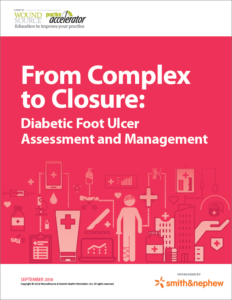
WoundSource Practice Accelerator: Wound Bed Preparation
JULY IS WOUND BED PREPARATION MONTH As part of the WoundSource Practice Accelerator series, we are offering you this educational portal into a variety of topics related to wound bed preparation with a focus on the the TIME framework, addressing tissue management strategies, infection/inflammation control, moisture balance and wound edge management. Please scroll below to choose your learning experience and please share this page with your social network and colleagues. Expanded awareness leads to better prevention and care. WATCH VIDEO View this month’s educational
Upcoming Webinar
WoundSource Practice Accelerator: Wound Bed Preparation
JULY IS WOUND BED PREPARATION MONTH As part of the WoundSource Practice Accelerator series, we are offering you this educational portal into a variety of topics related to wound bed preparation with a focus on the the TIME framework, addressing tissue management strategies, infection/inflammation control, moisture balance and wound edge management. Please scroll below to choose your learning experience and please share this page with your social network and colleagues. Expanded awareness leads to better prevention and care. WATCH VIDEO View this month’s educational resources. WEBINAR WHITE PAPER FACT SHEET QUIZ FEATURED ARTICLES ON-DEMAND WEBINAR Wound Bed Preparation: Applying the Principles of TIME Martha Kelso, RN, HBOT Preparing a wound for healing is key to ensure chronic wounds convert to healing wounds. Using the TIME mnemonic assists clinicians and bedside nurses to think critically when making decisions on treatment options. This webinar uses wound photographs paired with terminology to interpret what the wound is communicating. After reviewing the photos, various treatment options will be discussed. WATCH NOW DOWNLOADABLE WHITE PAPER The TIME Model of Wound Bed Preparation Effective wound bed preparation is a cornerstone of modern wound care by helping to promote rapid healing and minimize the risk of complications such as infection. This guide provides wound care professionals with clear foundational knowledge of the evidence-based TIME framework for wound bed preparation, as well as the latest information on the principles and benefits of preparing the wound bed for optimal healing outcomes. DOWNLOAD THE WHITE PAPER A Fact A Day- Wound Bed Preparation Download A Fact A Day - Wound Bed Preparation and share it within your facility. This two-page fact sheet was created to support staff education on preparing the wound bed for proper healing. The print-friendly format is perfect for posting on the bulletin board or distributing to your nursing staff at in-service. DOWNLOAD THE FACT SHEET SPONSORED BY: How Much Do You Know About Wound Bed Preparation Princples? Take our 13-question quiz to find out! TAKE THE QUIZ Terms to know: Wound Bed Preparation Bacterial load/burden: Presence of bacterial pathogens in an open wound contributing to wound chronicity and persistence of inflammatory cycle. There are several points along the spectrum of bacterial presence in chronic wounds: contamination, colonization, critical colonization, infection, and sepsis. Debridement: The procedural act of removing non-viable tissue, along with any debris, from the wound. There are multiple debridement modalities, some of which are selective for non-viable tissue and some which are non-selective (viable tissue is removed as well, e.g., mechanical debridement with gauze sponges): sharp (conservative or excisional/surgical), mechanical, autolytic, enzymatic/chemical, and biological. Read the full glossary READ THIS MONTH'S FEATURED ARTICLES Restoring the Wound Base: The Role of Tissue Management Successful utilization of the TIME model for wound bed preparation requires a working knowledge of chronic wound tissue types. In addition, building on this foundational knowledge is the development of... Read More Controlling Bacterial Burden in Chronic Wounds Bioburden in chronic wounds can be a principal contributor to inflammation, clinical wound infection, and further delayed wound healing. Clinically diagnosing infection in chronic wounds... Read More Wound Bed Preparation and Therapeutic Interventions: Key Assessment Strategies Before embarking on the journey of wound bed preparation, the goals for wound care should be carefully considered. A realistic look at the goals and expectations from... Read More The Science of Healing: Wound Bed Preparation Actions and Effects For wound healing to occur, a complex, well-defined cascade of events must take place in the body’s natural host processes. When this cascade of events is disturbed, a wound can fall into a state of non-healing... Read More SPONSORED BY For over 150 years, Smith & Nephew has taken a pioneering approach to product design and services, helping to reduce the human and economic costs of wounds. JULY IS WOUND BED PREPARATION MONTH









